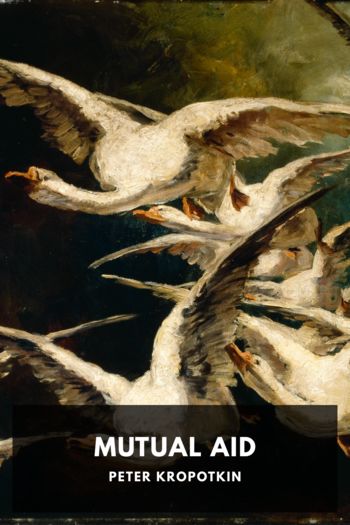Mutual Aid, Peter Kropotkin [fiction novels to read .txt] 📗

- Author: Peter Kropotkin
Book online «Mutual Aid, Peter Kropotkin [fiction novels to read .txt] 📗». Author Peter Kropotkin
The adaptivity of the lapwing makes it a species of which the range of extension is very wide. In England, it “makes itself at home on arable land as readily as in wilder areas.” Ch. Dixon says in his Birds of Northern Shires (p. 67), “Variety of food is still more the rule with the birds of prey.” Thus, for instance, we learn from the same author (pp. 60, 65), “that the hen harrier of the British moors feeds not only on small birds, but also on moles and mice, and on frogs, lizards and insects, while most of the smaller falcons subsist largely on insects.”
The very suggestive chapter which W. H. Hudson gives to the family of the South American treecreepers, or woodhewers, is another excellent illustration of the ways in which large portions of the animal population avoid competition, while at the same time they succeed in becoming very numerous in a given region, without being possessed of any of the weapons usually considered as essential in the struggle for existence. The above family covers an immense range, from South Mexico to Patagonia, and no fewer than 290 species, referable to about 46 genera, are already known from this family, the most striking feature of which is the great diversity of habits of its members. Not only the different genera and the different species possess habits peculiarly their own, but even the same species is often found to differ in its manner of life in different localities. “Some species of Xenops and Magarornis, like woodpeckers, climb vertically on tree-trunks in search of insect prey, but also, like tits, explore the smaller twigs and foliage at the extremity of the branches; so that the whole tree, from the root to its topmost foliage, is hunted over by them. The Sclerurus, although an inhabitant of the darkest forest, and provided with sharply-curved claws, never seeks its food on trees, but exclusively on the ground, among the decaying fallen leaves; but, strangely enough, when alarmed, it flies to the trunk of the nearest tree, to which it clings in a vertical position, and, remaining silent and motionless, escapes observation by means of its dark protective colour.” And so on. In their nesting habits they also vary immensely. Thus, in one single genus, three species build an oven-shaped clay-nest, a fourth builds a nest of sticks in the trees, and a fifth burrows in the side of a bank, like a kingfisher.
Now, this extremely large family, of which Hudson says that “every portion of the South American continent is occupied by them; for there is really no climate, and no kind of soil or vegetation, which does not possess its appropriate species, belongs”—to use his own words—“to the most defenceless of birds.” Like the ducks which were mentioned by Syevertsoff (see in the text), they display no powerful beak or claws; “they are timid, unresisting creatures, without strength or weapons; their movements are less quick and vigorous than those of other kinds, and their flight is exceedingly feeble.” But they possess—both Hudson and Asara observe—“the social disposition in an eminent degree,” although “the social habit is kept down in them by the conditions of a life which makes solitude necessary.” They cannot make those large breeding associations which we see in the seabirds, because they live on the tree-insects, and they must carefully explore separately every tree—which they do in a most businesslike way; but they continually call each other in the woods, “conversing with one another over long distances;” and they associate in those “wandering bands” which are well known from Bates’ picturesque description, while Hudson was led to believe “that everywhere in South America the Dendrocolaptidae are the first in combining to act in concert, and that the birds of other families follow their march and associate with them, knowing from experience that a rich harvest may be reaped.” It hardly need be added that Hudson pays them also a high compliment concerning their intelligence. Sociability and intelligence always go hand in hand.
VII The Origin of the FamilyAt the time when I wrote the chapter inserted in the text, a certain accord seemed to have been established amongst anthropologists concerning the relatively late appearance, in the institutions of men, of the patriarchal family, such as we know it among the Hebrews, or in Imperial Rome. However, works have been published since, in which the ideas promulgated by Bachofen and MacLennan, systematized especially by Morgan, and further developed and confirmed by Post, Maxim Kovalevsky, and Lubbock, were contested—the most important of such works being by the Danish Professor, C. N. Starcke (Primitive Family, 1889), and by the Helsingfors Professor, Edward Westermarck (The History of Human Marriage, 1891; 2nd ed. 1894). The same has happened with this question of primitive marriage institutions as it happened with the question of the primitive land-ownership institutions. When the ideas of Maurer and Nasse on the village community developed by quite a school of gifted explorers, and those of all modern anthropologists upon the primitively communistic constitution of the clan had nearly won general acceptance—they called forth the appearance of such works as those of Fustel de Coulanges in France, the Oxford Professor Seebohm in England, and several others, in which an attempt was made—with more brilliancy than real depth of investigation—to undermine these ideas and to cast a doubt upon the conclusions arrived at by modern research (see Prof. Vinogradov’s Preface to his remarkable work, Villainage in England).





Comments (0)